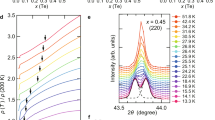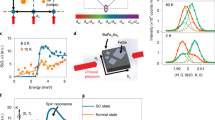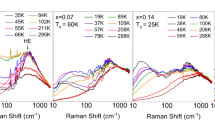Abstract
The interplay of different electronic phases underlies the physics of unconventional superconductors. One of the most intriguing examples is a high-temperature superconductor, FeTe1 – xSex (refs. 1,2,3,4,5,6,7,8,9,10,11). This superconductor undergoes both a topological transition3,4, linked to the electronic band inversion, and an electronic nematic phase transition, associated with rotation symmetry breaking, around the same Se composition where the superconducting transition temperature peaks12,13. In this regime, nematic fluctuations and symmetry-breaking strain could be important, but this is yet to be fully explored. Using spectroscopic-imaging scanning tunnelling microscopy, we study the electronic nematic transition in FeTe1 – xSex as a function of composition. Near the critical Se composition, we find electronic nematicity in nanoscale regions. The superconducting coherence peaks are suppressed in areas where static nematic order is the strongest. By analysing atomic displacement in scanning tunnelling microscopy topographs, we find that small anisotropic strain can give rise to these strongly nematic localized regions. Our experiments reveal a tendency of FeTe1 – xSex, near x ≈ 0.45, to form puddles hosting static nematic order, suggestive of nematic fluctuations pinned by structural inhomogeneity, and demonstrate the effect of anisotropic strain on superconductivity in this regime.
This is a preview of subscription content, access via your institution
Access options
Access Nature and 54 other Nature Portfolio journals
Get Nature+, our best-value online-access subscription
$29.99 / 30 days
cancel any time
Subscribe to this journal
Receive 12 print issues and online access
$209.00 per year
only $17.42 per issue
Buy this article
- Purchase on Springer Link
- Instant access to full article PDF
Prices may be subject to local taxes which are calculated during checkout




Similar content being viewed by others
Data availability
Data that support the plots within this paper and other findings of this study are available from the corresponding author upon reasonable request. Source data are provided with this paper.
Code availability
The computer code used for data analysis is available upon request from the corresponding author.
References
Fang, M. H. et al. Superconductivity close to magnetic instability in Fe(Se1 − xTex)0.82. Phys. Rev. B 78, 224503 (2008).
Hanaguri, T., Niitaka, S., Kuroki, K. & Takagi, H. Unconventional s-wave superconductivity in Fe(Se,Te). Science 328, 474–476 (2010).
Zhang, P. et al. Multiple topological states in iron-based superconductors. Nat. Phys. 15, 41–47 (2019).
Zhang, P. et al. Observation of topological superconductivity on the surface of an iron-based superconductor. Science 360, 182–186 (2018).
Wang, D. et al. Evidence for Majorana bound states in an iron-based superconductor. Science 362, 333–335 (2018).
Cho, D., Bastiaans, K. M., Chatzopoulos, D., Gu, G. D. & Allan, M. P. A strongly inhomogeneous superfluid in an iron-based superconductor. Nature 571, 541–545 (2019).
Wang, Z. et al. Evidence for dispersing 1D Majorana channels in an iron-based superconductor. Science 367, 104–108 (2020).
Machida, T. et al. Zero-energy vortex bound state in the superconducting topological surface state of Fe(Se,Te). Nat. Mater. 18, 811–816 (2019).
Yin, J.-X. et al. Observation of a robust zero-energy bound state in iron-based superconductor Fe(Te,Se). Nat. Phys. 11, 543–546 (2015).
Singh, U. R. et al. Evidence for orbital order and its relation to superconductivity in FeSe0.4Te0.6. Sci. Adv. 1, e1500206 (2015).
Kong, L. et al. Half-integer level shift of vortex bound states in an iron-based superconductor. Nat. Phys. 15, 1181–1187 (2019).
Mizuguchi, Y. & Takano, Y. Review of Fe chalcogenides as the simplest Fe-based superconductor. J. Phys. Soc. Jpn 79, 102001 (2010).
Terao, K., Kashiwagi, T., Shizu, T., Klemm, R. A. & Kadowaki, K. Superconducting and tetragonal-to-orthorhombic transitions in single crystals of FeSe1 − xTex (0 ≤ x ≤ 0.61). Phys. Rev. B 100, 224516 (2019).
Kuo, H.-H., Chu, J.-H., Palmstrom, J. C., Kivelson, S. A. & Fisher, I. R. Ubiquitous signatures of nematic quantum criticality in optimally doped Fe-based superconductors. Science 352, 958–962 (2016).
Chu, J.-H. et al. In-plane resistivity anisotropy in an underdoped iron arsenide superconductor. Science 329, 824–826 (2010).
Chu, J.-H., Kuo, H.-H., Analytis, J. G. & Fisher, I. R. Divergent nematic susceptibility in an iron arsenide superconductor. Science 337, 710–712 (2012).
Yi, M., Zhang, Y., Shen, Z.-X. & Lu, D. Role of the orbital degree of freedom in iron-based superconductors. npj Quantum Mater. 2, 57 (2017).
Rosenthal, E. P. et al. Visualization of electron nematicity and unidirectional antiferroic fluctuations at high temperatures in NaFeAs. Nat. Phys. 10, 225–232 (2014).
Chuang, T.-M. et al. Nematic electronic structure in the ‘parent’ state of the iron-based superconductor Ca(Fe1 – xCox)2As2. Science 327, 181–184 (2010).
Kostin, A. et al. Imaging orbital-selective quasiparticles in the Hund’s metal state of FeSe. Nat. Mater. 17, 869–874 (2018).
Song, C.-L. et al. Direct observation of nodes and twofold symmetry in FeSe superconductor. Science 332, 1410–1413 (2011).
Hanaguri, T. et al. Two distinct superconducting pairing states divided by the nematic end point in FeSe1 – xSx. Sci. Adv. 4, eaar6419 (2018).
Licciardello, S. et al. Electrical resistivity across a nematic quantum critical point. Nature 567, 213–217 (2019).
Zhou, R. et al. Quantum criticality in electron-doped BaFe2 − xNixAs2. Nat. Commun. 4, 2265 (2013).
Yim, C. M. et al. Discovery of a strain-stabilised smectic electronic order in LiFeAs. Nat. Commun. 9, 2602 (2018).
Wang, P. S. et al. Robust short-range-ordered nematicity in FeSe evidenced by high-pressure NMR. Phys. Rev. B 96, 094528 (2017).
Reiss, P. et al. Quenched nematic criticality and two superconducting domes in an iron-based superconductor. Nat. Phys. 16, 89–94 (2020).
Miao, H. et al. Isotropic superconducting gaps with enhanced pairing on electron Fermi surfaces in FeTe0.55Se0.45. Phys. Rev. B 85, 094506 (2012).
Yi, M. et al. Observation of universal strong orbital-dependent correlation effects in iron chalcogenides. Nat. Commun. 6, 7777 (2015).
Rinott, S. et al. Tuning across the BCS-BEC crossover in the multiband superconductor Fe1 + ySexTe1 − x : an angle-resolved photoemission study. Sci. Adv. 3, e1602372 (2017).
Dong, C. et al. Revised phase diagram for the FeTe1 − xSex system with fewer excess Fe atoms. Phys. Rev. B 84, 224506 (2011).
Sun, Y., Shi, Z. & Tamegai, T. Review of annealing effects and superconductivity in Fe1 + yTe1 − xSex superconductors. Supercond. Sci. Technol. 32, 103001 (2019).
Dong, L., Zhao, H., Zeljkovic, I., Wilson, S. D. & Harter, J. W. Bulk superconductivity in FeTe1 − xSex via physicochemical pumping of excess iron. Phys. Rev. Mater. 3, 114801 (2019).
Zeljkovic, I. et al. Strain engineering Dirac surface states in heteroepitaxial topological crystalline insulator thin films. Nat. Nanotechnol. 10, 849–853 (2015).
Gao, S. et al. Atomic-scale strain manipulation of a charge density wave. Proc. Natl Acad. Sci. USA 115, 6986–6990 (2018).
Wahl, P., Singh, U. R., Tsurkan, V. & Loidl, A. Nanoscale electronic inhomogeneity in FeSe0.4Te0.6 revealed through unsupervised machine learning. Phys. Rev. B 101, 115112 (2020).
Singh, U. R. et al. Spatial inhomogeneity of the superconducting gap and order parameter in FeSe0.4Te0.6. Phys. Rev. B 88, 155124 (2013).
Malinowski, P. et al. Suppression of superconductivity by anisotropic strain near a nematic quantum critical point. Nat. Phys. 16, 1189–1193 (2020).
Lederer, S., Schattner, Y., Berg, E. & Kivelson, S. A. Enhancement of superconductivity near a nematic quantum critical point. Phys. Rev. Lett. 114, 097001 (2015).
Acknowledgements
I.Z. gratefully acknowledges support from Army Research Office grant W911NF-17-1-0399 (STM experiments) and National Science Foundation grant NSF-DMR-1654041 (strain analysis). The work at Brookhaven was supported by the Office of Basic Energy Sciences, US Department of Energy (DOE) under contract DE-SC0012704. Support was provided via the UC Santa Barbara NSF Quantum Foundry funded under the Q-AMASE-i initiative under award DMR-1906325 (S.D.W. and J.H.). L.D. was supported by the Materials Research Science and Engineering Centers (MRSEC) programme of the National Science Foundation through grant no. DMR-1720256 (Seed Program). Z.W. acknowledges support from US Department of Energy, Basic Energy Sciences grant DE-FG02-99ER45747. The work in Zhejiang University is supported by the National Key R&D Program of China under grant 2016YFA0300402 and the National Natural Science Foundation of China (grants NSFC-12074335 and 11974095).
Author information
Authors and Affiliations
Contributions
STM experiments were carried out by H.Z. and H.L. L.D., B.X., J.S. and R.Z. grew the Fe(Te,Se) single crystals, supervised by M.F., G.G., J.H. and S.D.W. H.Z. and H.L. analysed the STM data with guidance from I.Z. Z.W. provided theoretical input on the interpretation of STM data. I.Z., Z.W., H.Z. and S.D.W. wrote the manuscript with input from all the authors. I.Z. supervised the project.
Corresponding author
Ethics declarations
Competing interests
The authors declare no competing interests.
Additional information
Peer review information Nature Physics thanks Milan Allan, Michael Lawler and the other, anonymous, reviewer(s) for their contribution to the peer review of this work.
Publisher’s note Springer Nature remains neutral with regard to jurisdictional claims in published maps and institutional affiliations.
Supplementary information
Supplementary Information
Supplementary Discussions 1–8, Tables 1 and 2, Figs. 1–16 and references 1–5.
Source data
Source Data Fig. 3
Raw data for Fig. 3b,c,g,h,l,m.
Source Data Fig. 4
Raw data for Fig. 4f.
Rights and permissions
About this article
Cite this article
Zhao, H., Li, H., Dong, L. et al. Nematic transition and nanoscale suppression of superconductivity in Fe(Te,Se). Nat. Phys. 17, 903–908 (2021). https://doi.org/10.1038/s41567-021-01254-8
Received:
Accepted:
Published:
Issue Date:
DOI: https://doi.org/10.1038/s41567-021-01254-8
This article is cited by
-
Electronic nematicity without charge density waves in titanium-based kagome metal
Nature Physics (2023)
-
Roadmap of the iron-based superconductor Majorana platform
Science China Physics, Mechanics & Astronomy (2023)
-
Preparation of spatially uniform monolayer FeSexTe1−x (0 < x ≤ 1) by topotactic reaction
Nano Research (2023)
-
Visualization of edge-modulated charge-density-wave orders in monolayer transition-metal-dichalcogenide metal
Communications Physics (2022)
-
Correlation-driven electronic reconstruction in FeTe1−xSex
Communications Physics (2022)



